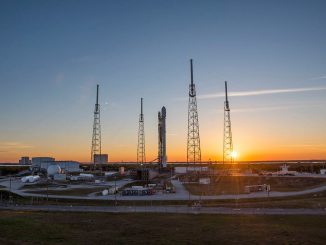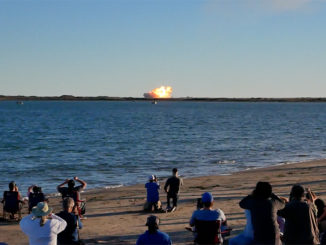
For a tenth time in a little more than three years, SpaceX conducted a rideshare mission, carrying dozens of small payloads, called CubeSats and MicroSats, to low Earth orbit. The mission, dubbed Transporter-10,launched from Vandenberg Space Force Base, Monday afternoon.
Liftoff of the Falcon 9 rocket from Space Launch Complex 4 East (SLC-4E) occurred at 2:05 p.m. PST (5:05 p.m. EST, 2205 UTC).
SpaceX advertises these missions as a continuous opportunity for those wanting to launch smaller payloads to have a way of getting to a variety of orbital inclinations. On its website, the company advertises getting a 50kg payload to sun-synchronous orbit (SSO) for $300,000 “with additional mass at $6,000 per kilogram.”
Transporter missions can also be launched to mid-inclination low Earth orbit, geostationary transfer orbit and trans-lunar injection. SpaceX states that its Transporter mission are scheduled to launch roughly every four months to mid-inclination orbit.
About 7.5 minutes after liftoff, the first stage booster, tail number B1081 in the SpaceX fleet, touchdown at Landing Zone 4. This was the fifth flight for this booster, which flew all of its prior missions from Cape Canaveral Space Force Station in Florida. That included the launch the Crew-7 mission, a Cargo Dragon mission to the International Space Station, a batch of Starlink satellites and NASA’s Earth-monitoring PACE spacecraft.
Technology demonstrations and climate change advancements
The Transporter-10 mission featured 53 payloads, which were deployed by a variety of companies. Leading that pack was Exolaunch, which carried 28 satellites for its customers.
NASA’s Launch Services Program (LSP) also helped get a payload onboard this mission. The agency’s CubeSat Launch Initiative (CSLI) manifested the 3U CubeSate from Missouri University of Science and Technology as the sole payload for the Educational Launch of Nanosatellites 57 (ELaNa 57) mission.
The Multi-Mode Mission (M3) payload began as a NASA-funded project at the university back in 2016. In a S&T statement, the university said “once the small, cube-shaped satellite is in space, it will test an experimental thruster that was developed in the Missouri S&T Advanced Plasma Lab in partnership with Froberg Aerospace.”
“The propulsion system will include both chemical and electric components and also be fed a liquid propellent,” the university stated. “The thruster will be fired multiple times in space for 30-second bursts.”
https://twitter.com/NASA_LSP/status/1764659812850106813
Another NASA payload is hitching a ride onboard a company located on Florida’s Space Coast: Sidus Space. The inaugural LizzieSat-1 (LS-1), named after founder and CEO Carol Craig (biologically named Elizabeth Sanchez), carries what NASA’s Stennis Space Center describes as “the Center’s first-ever in-flight autonomous systems software mission.”
“Each step brings us a step closer to deployment of ASTRA (Autonomous Satellite Technology for Resilient Applications) in space,” said Chris Carmichael, NASA Stennis Autonomous Systems Laboratory (ASL) Branch Chief said in a statement in mid-February. “We are excited with the progress as we continue to collaborate with Sidus Space on this truly historic mission for the Center.”

The final payload deployed on the Transporter-10 mission is an Earth observing satellite called MethaneSAT, which was created by a subsidiary of the non-profit Environmental Defense Fund.
As the name suggests, MethaneSAT is designed to monitor both the source and the quantity of methane being produced around the globe. It will orbit the Earth once every 95 minutes and is intended to “collect data from 300 targets accounting for 80 percent of global oil and gas production,” the non-profit said.
“MethaneSAT’s superpower is the ability to precisely measure methane levels with high resolution over wide areas, including smaller, diffuse sources that account for most emissions in many regions,” said Steven Hamburg, EDF Chief Scientist and MethaneSAT project leader in a statement. “Knowing how much methane is coming from where and how the rates are changing is essential.”
The most powerful methane detection satellite ever built was just launched into space. MethaneSat will offer unmatched accuracy and precision in measuring global methane emissions across time.
I am proud to be a funder and adviser to the project. I come from the nat gas… pic.twitter.com/KbPXqG2aXE
— John Arnold (@JohnArnoldFndtn) March 4, 2024
The project is funded through a combination of donors to EDF and a partnership with the Government of New Zealand. The largest donors are listed by the non-profit as the Bezos Earth Fund, Arnold Ventures, the Robertson Foundation and the TED Audacious Project.
“You can’t manage what you can’t measure, and that’s certainly true when it comes to cutting methane, one of the biggest drivers of climate change,” said Michael R. Bloomberg, UN Secretary-General’s Special Envoy on Climate Ambition and Solutions and Founder of Bloomberg LP and Bloomberg Philanthropies in a statement.
“Data from this satellite will help us to better measure methane emissions and target their sources, bringing more transparency to the problem, giving companies and investors the information they need to take action, and empowering the public to hold people accountable.”




